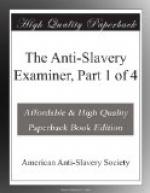such a cultivation of their crops as would provide
them with bread, and such care of their immense flocks
and herds, as would secure their profitable increase,
must have kept at home the main body of the nation.
During the plague of darkness, God informs us that
“ALL the children of Israel had light in their
dwellings.” We infer that they were there
to enjoy it. See also Ex. ix. 26. It seems
improbable that the making of brick, the only service
named during the latter part of their sojourn in Egypt,
could have furnished permanent employment for the bulk
of the nation. See also Ex. iv. 29-31. Besides,
when Eastern nations employed tributaries, it was
as now, in the use of the levy, requiring them to
furnish a given quota, drafted off periodically, so
that comparatively but a small portion of the nation
would be absent at any one time. The adult
males of the Israelites were probably divided into
companies, which relieved each other at stated intervals
of weeks or months. It might have been during
one of these periodical furloughs from service that
Aaron performed the journey to Horeb. Ex. iv.
27. At the least calculation this journey must
have consumed eight weeks. Probably one-fifth
part of the proceeds of their labor was required of
the Israelites in common with the Egyptians.
Gen. xlvii. 24, 26. Instead of taking it from
their crops, (Goshen being better for pasturage)
they exacted it of them in brick making; and labor
might have been exacted only from the poorer
Israelites, the wealthy being able to pay their tribute
in money. The fact that all the elders of Israel
seem to have controlled their own time, (See Ex. iv.
29; iii. 16; v. 20,) favors the supposition.
Ex. iv. 27, 31. Contrast this bondage of Egypt
with American slavery. Have our slaves “flocks
and herds even very much cattle?” Do they live
in commodious houses of their own, “sit by the
flesh-pots,” “eat fish freely,” and
“eat bread to the full”? Do they
live in a separate community, in their distinct tribes,
under their own rulers, in the exclusive occupation
of an extensive tract of country for the culture of
their crops, and for rearing immense herds of their
own cattle—and all these held inviolable
by their masters? Are our female slaves free
from exactions of labor and liabilities of outrage?
or when employed, are they paid wages, as was the
Israelitish woman by the king’s daughter?
Have they the disposal of their own time, and the means
for cultivating social refinements, for practising
the fine arts, and for personal improvement?
THE ISRAELITES UNDER THE BONDAGE OF EGYPT, ENJOYED
ALL THESE RIGHTS AND PRIVILEGES. True, “all
the service wherein they made them serve was with
rigor.” But what was this when compared
with the incessant toil of American slaves; the robbery
of all their time and earnings, and even the “power
to own any thing, or acquire any thing?” a “quart
of corn a-day,” the legal allowance of food![C]
their only clothing for one half the year,




